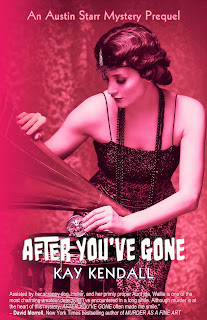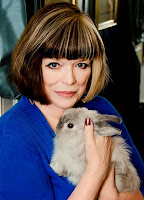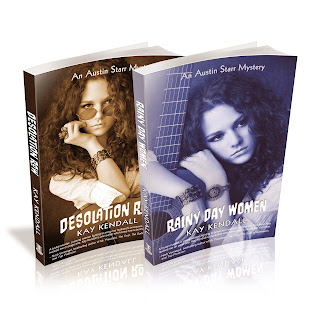Writing by the Bechdel Rule—and Not Even Knowing it
by Kay Kendall
three decades, I never heard about it until seven years ago when it first popped
up in film reviews in the New York Times.
Now, I love movies and try hard to keep abreast of trends, so I looked it up
pretty quick. I don’t like feeling behind the times.
movies by three criteria: (1) it has to have at least two
women in it, who (2) talk to each other, about (3) something besides a man. Cartoon
illustrator Alison Bechdel popularized her pal Liz Wallace’s concept in the
comic strip Dykes to Watch Out For in
1985. There are now 8,151 movies listed at bechdeltest.com that pass the test.
the test’s definition, I was astonished. Movies I watch and books I read
routinely pass this test, even before I knew it existed. The first mystery I
was in the midst of writing, Desolation
Row, passed as do the two books that followed.
born a feminist so it’s no wonder this rule was one I lived by. There are
fictional female characters to whom I give credit for prodding me along my way.
They include the mighty Jane Eyre, the extremely curious Nancy Drew, and even
the tragic Anna Karenina. After all, the Russian woman came to a very bad end indeed
by living only for the love of a man and nothing else.
recently returned to my treasured copy of Jane
Eyre to see if it held up to my current feelings about living one’s life as
a female. Again I was astonished because the proto feminism of the novel was
laid out on almost every page. For example, look at this passage, written in
complete contrast to the fate of poor Anna Karenina: “I am no bird; and no net ensnares me: I am a free human being
with an independent will.”
passage from Jane Eyre, here is
another one, a real doozy, given the era it was written in, the 1850s in
Victorian England:
feel just as men feel; they need exercise for their faculties, and a field for
their efforts, as much as their brothers do; they suffer from too rigid a
restraint, to absolute a stagnation, precisely as men would suffer; and it is
narrow-minded in their more privileged fellow-creatures to say that they ought
to confine themselves to making puddings and knitting stockings, to playing on
the piano and embroidering bags. It is thoughtless to condemn them, or laugh at
them, if they seek to do more or learn more than custom has pronounced
necessary for their sex.”
And yet Jane Eyre is also a magnificent love story because of the heroine’s
passion for Mr. Rochester. Proving that she could be not only independent but
in love too, she most famously stated, “Reader, I married him.”
1970s and declined thereafter. Feminism was attacked as being anti-male. I
always thought that was utter bosh, complete nonsense. I am delighted that has
changed of late. We women can stand up for ourselves without trashing all men,
for certainly all men do not deserve that, only the ones who seek to hold women
down, to keep us, as the Rolling Stones gleefully sing, “Under My Thumb.”
title from the Stones, and in my third mystery, After You’ve Gone, I have my heroine quote Jane Eyre, “I am no
bird; and no net ensnares me.”
with flying colors snared me as a young reader, and they do so today as well.
And, dear reader, now I write them too.
Kendall is passionate about historical mysteries. She lives in Texas with
her Canadian husband, three house rabbits, and spaniel Wills. Her second book Rainy Day Women won the Silver Falchion for best mystery at Killer Nashville.
her website http://www.austinstarr.com/
or on Facebook at
https://www.facebook.com/KayKendallAuthor






